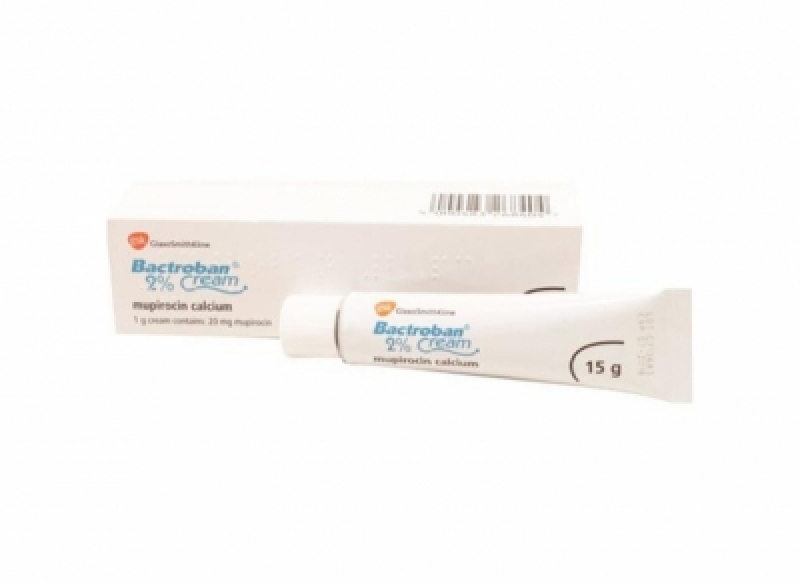Bactroban's main ingredient is mupirocin. Bactroban is a topical antibiotic used to treat superficial skin infections. These might include impetigo, caused by the bacteria Staphylococcus aureus.
Mupirocin, the active ingredient, is an antibiotic that prevents bacteria from growing on your skin. Mupirocin works by targeting and affecting the bacteria's production of certain proteins necessary for its survival. Instead, it forces the bacteria to produce abnormal and faulty proteins, ultimately killing the bacteria and clearing up the infection.
Bactroban cream is used to treat impetigo and to treat infections on your skin in small cuts, lacerations, wounds or on scraped skin, by killing bacteria causing infections on your skin called ‘Staphylococcus aureus’ and ‘Streptococcus pyogens’.
The patient should see their infection clear up and the area around the skin returns to normal, with some observation being recommended to avoid the infection from returning.
You usually apply Bactroban on your skin up to 3 times a day. Use Bactroban for as long as your clinician has told you. You should not scratch or pick at the infected area before, during or after treatment.
The bacteria are normally cleared from your skin within 10 days of starting treatment. Do not use it for more than 10 days. Throw away any cream that is left over. If your skin condition does not improve within 3 to 5 days, see your doctor.
Follow the instructions below to ensure appropriate use of this medication:
- Wash your hands thoroughly with warm water and soap
- Place a small amount of Bactroban on a clean cotton wool pad or gauze swab.
- Apply the cream to the infected area of your skin.
- You can cover the treated area with a plaster or other suitable dressing, unless your doctor has told you to leave it uncovered.
- Be careful to avoid your eyes if you use it on your face (If you accidentally get any in your eye, wash it out with cold water straight away, then bathe your eye with eyewash if possible)
- Replace the cap on the tube and wash your hands
In the event you miss a dose, it is safe to apply the missed dose as soon as possible. However, if enough time has passed that you should be applying your next dose instead, simply skip the missed dose and resume your typical application schedule.
Always use this medication exactly as your clinician has told you. Check with our clinical team or your GP or pharmacist if you are not sure.
Medicines and their possible side effects can affect individual people in different ways. The following are some of the side effects that are known to be associated with this medicine. Just because a side effect is stated here, it does not mean that all people using this medicine will experience that or any side effect.
Common Bactroban side effects may include:
- Burning
- Stinging
- Itching
- Pain
Less common side effects include:
- Skin changes to the application site
- Intense blistering
- Irritation
- Reddening
- Cracking and dryness of the skin
If you typically experience diarrhoea, be aware that this symptom has been worsened through the use of Bactroban. Diarrhoea may occur several months after the use of Bactroban is discontinued.
For full information on side effects and correct use, see the patient information leaflet. If any side effects concern you, or you are experiencing any of the side effects mentioned in the patient information leaflet whilst taking this medication, please contact our clinical team or speak to your GP.
Avoid your eyes, nose, mouth, and lips when applying Bactroban. If medication gets in any of these areas, wash with water. Watch for signs of improvement in 3 to 5 days. If your condition gets worse or does not improve, see your GP.
Call your GP straight away if you have:
- Severe stomach pain
- Diarrhea that is watery or bloody
- Severe itching, rash, or other irritation of treated skin
- Unusual skin blisering or peeling
- Any signs of a new skin infection
Get emergency medical help if you have signs of an allergic reaction to this medication. These include:
- Hives
- Dizziness
- Fast or pounding heartbeats
- Wheezing
- Difficult breathing
- Swelling of your face, lips, tongue, or throat.
It is important that you let us know which prescription, over-the-counter medicines and recreational drugs you are currently taking. You must also tell us about any other medical conditions that you currently have (or had in the past). This will help us ensure the prescribed medication is safe and appropriate for you to take.
For full information on warnings, medication interactions and contraindications, refer to the Patient Information Leaflet. Please read all packaging and the Patient Information Leaflet before taking any new medicine and inform our clinical team or your GP of medicines you are taking or intend to take.







